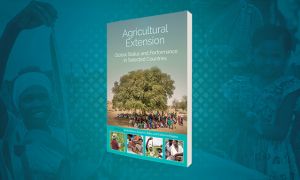Climate change is not projected to materially alter Malawi’s climate profile. Instead, it is likely to exacerbate existing climate vulnerabilities by increasing the frequency and intensity of cyclones, floods, and droughts.
Search
農業の変革と発展は、開発途上国の10億人以上の小規模農家をはじめ農村に 暮らす人々の生活にとって非常に重要である農業改良普及は、こうした変革 において重要な役割を果たし、アドバイス、情報提供、イノベーション、関係の仲介・促進、リスクや災害への対応などにより農民を支援することがで きる。本書は、農業改良普及の世界的な概要を示し、国および地域レベルの 改良普及システムを評価・比較し、以下の分野における改良普及アプローチ のパフォーマンスを検証している。
With the onset of the COVID-19 pandemic, CGIAR pivoted its research planning to better support countries as they responded to the crisis.
How can extension services best help small farmers meet today’s challenges? This global study points to ways to improve outcomes, enhance financial sustainability, and achieve greater scale.
Conclusions and policy implications
The two objectives of this book are to assess extension and advisory services in a cross-country comparative context in the following ways: 1.
Introduction and motivation
Agricultural development is critical to the livelihoods of more than a billion small-scale farmers and other rural populations in developing countries.
Agricultural transformation and development are critical to the livelihoods of more than a billion small-scale farmers and other rural people in developing countries.
Policymakers need to know what policies, investments, and actions they can take to ensure food systems transform in a healthy, sustainable, and equitable way.
This chapter examines the headway that has been made in Malawi in bringing the agriculture sector on board as a partner in addressing malnutrition multisectorally, and the factors that are driving progress.
Agriculture's vast potential to improve nutrition is just beginning to be tapped.
Accelerating progress to end hunger and undernutrition in Bangladesh, Ethiopia, Malawi, and Rwanda
Compact2025 is a bold new initiative for ending hunger and undernutrition by 2025.
Following poor harvests in the 2015/16 cropping season in Malawi, vulnerability assessments found that nearly 6.7 million people, primarily in the Southern and Central regions, were likely to suffer from food insecurity before the next harvest.
This scoping report was prepared to inform the Compact2025 roundtable discussion by providing an overview of the food security and nutrition challenges and opportunities in Malawi.
Micronutrient policy process in Malawi
Micronutrient deficiencies are common across the developing world and have major effects on the health outcomes of its population. Although this is well understood, many countries find it difficult to bring about policy change in this regard.
Impacts of biofuel production on the food-energy-water nexus in Malawi
The 193 individual country profiles capture the status and progress of all UN Member States, and the 80+ indicators include a wealth of information on child, adolescent and adult anthropometry and nutritional status, in addition to intervention co
Nineteen briefs provide different perspectives on aflatoxin risks and solutions.


